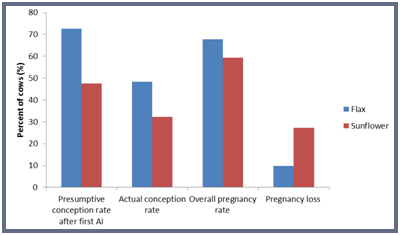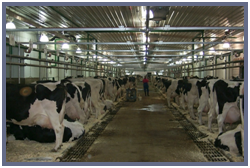| | Fatty acids can help improve energy balance and enhance reproduction
Due to their caloric density, dietary fats may reduce the harmful negative energy balance that commonly occurs at the beginning of lactation, improving reproductive performance. In addition, polyunsaturated long chain fatty acids like α-linolenic acid (ALA) seem to have a particularly beneficial effect on reproduction by reducing the synthesis of prostaglandin F2α and improving pregnancy rates.
Our study used 121 cows that were fed 750 g per day of either flaxseed, which is high ALA, or sunflower seed, which is low in ALA. After being synchronized for ovulation, the cows were artificially inseminated. Blood progesterone was measured at 21 and 24 days after insemination to indirectly determine if they had conceived; pregnancy was confirmed by ultrasound at 32 days. Cows that were not pregnant were re-inseminated 10 days later.
Flax may reduce pregnancy losses and increase rates of early embryo survival

More embryos in the flax-fed cows survived the first 3 weeks of pregnancy than in sunflower-fed cows. However, rates of embryo survival between days 24 and 32 after conception did not differ between the groups, indicating that the flax cows’ higher overall conception rate was due to differences during the early period of development.
Flax-fed cows carried more calves to term than sunflower-fed cows. This effect may be because flax-fed cows ovulated larger follicles, which may have yielded more viable oocytes than from smaller follicles of sunflower-fed cows.
It is important to note that these cows were fed their respective diets for only 4 weeks before and after artificial insemination. Therefore, flax supplementation for extended periods of time is probably not necessary to reap its benefits.
Diet affected the fatty acid concentration and composition of milk
Milk fat yield and concentration declined in the first 4 weeks of feeding in cows fed sunflower seed, but did not change in those fed flax. Both fatty acid sources decreased medium chain fatty acids and increased long chain fatty acids. In particular, flax-fed cows nearly tripled the amount of ALA in their milk, indicating that much of the fatty acids in the flax bypassed modifications in the rumen.
Overall milk yield and protein content were not affected by these dietary additions.
Dietary flax did not decrease feed intake
Although the addition of dietary fats can reduce dry matter intake, we found that intake was not affected by the inclusion of flaxseed. However, intake was slightly reduced in cows fed sunflower seed. This difference did not affect body weight or BCS, as both were relatively similar between the groups.
Conclusions

The inclusion of flaxseed as a source of alpha-linolenic acid in the diets of lactating dairy cows for 4 weeks before and 4 weeks after insemination increased early embryo survival and reduce pregnancy losses. However, the mechanisms by which these beneficial effects occur are unclear. Despite the promising nature of the present findings, larger field trials must be undertaken to confirm the beneficial effects of flaxseed on reproductive performance.
Acknowledgements
This research was supported by funds from Alberta Milk, Agriculture and Agri-Food Canada’s Matching Investment Initiative, and Alberta Agriculture and Rural Development. We thank Pioneer Hi-Bred Limited, Schering Canada, and Vetoquinol Canada for product donations. |
|